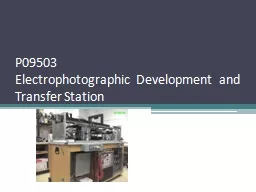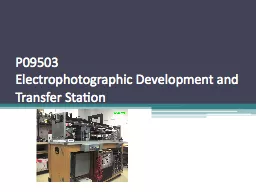PPT-P09503
Author : calandra-battersby | Published Date : 2017-07-29
Electrophotographic Development and Transfer Station Team Members Name Discipline Role David Schwartz ISE Team Lead Warning Signs Ruth Gay ME Paper Delivery System
Presentation Embed Code
Download Presentation
Download Presentation The PPT/PDF document "P09503" is the property of its rightful owner. Permission is granted to download and print the materials on this website for personal, non-commercial use only, and to display it on your personal computer provided you do not modify the materials and that you retain all copyright notices contained in the materials. By downloading content from our website, you accept the terms of this agreement.
P09503: Transcript
Electrophotographic Development and Transfer Station Team Members Name Discipline Role David Schwartz ISE Team Lead Warning Signs Ruth Gay ME Paper Delivery System Phillip Lopez ME. Electrophotographic Development and Transfer Station. Team Members. Name. Discipline. David Schwartz. ISE. Ruth Gay. ME. Phillip Lopez. ME. Dan Summers. ME. Rachel Chrash. EE. Min-Shi Hsiao. EE. Andrew Kearns. Team Members. Name. Discipline. David Schwartz. ISE. Ruth Gay. ME. Phillip Lopez. ME. Dan Summers. ME. Rachel Chrash. EE. Min-Shi Hsiao. EE. Andrew Kearns. EE. Sasha Oliver. CE. Project Description. The purpose of this project is to make an existing electrophotographic development and transfer station functional and to improve the usability, safety and sensing abilities. .
Download Document
Here is the link to download the presentation.
"P09503"The content belongs to its owner. You may download and print it for personal use, without modification, and keep all copyright notices. By downloading, you agree to these terms.
Related Documents


